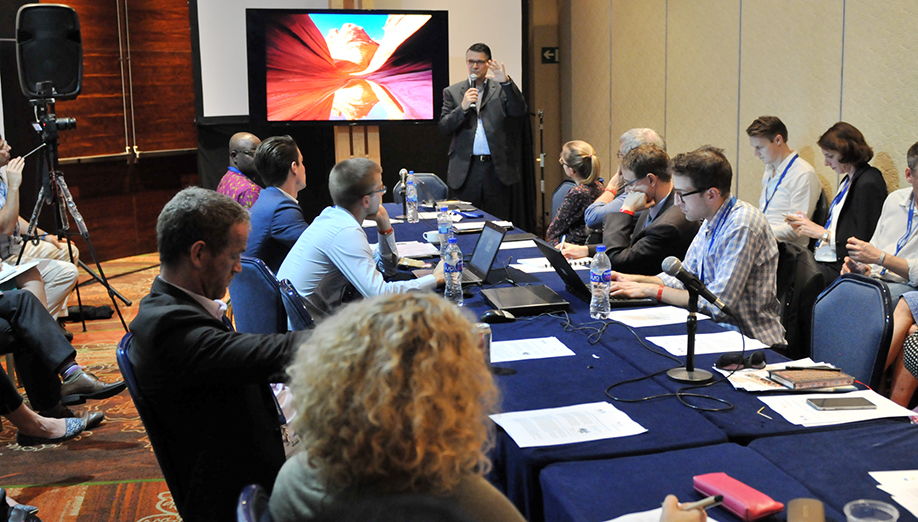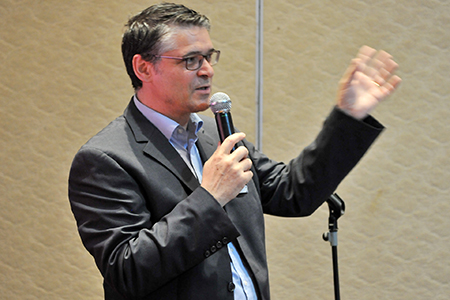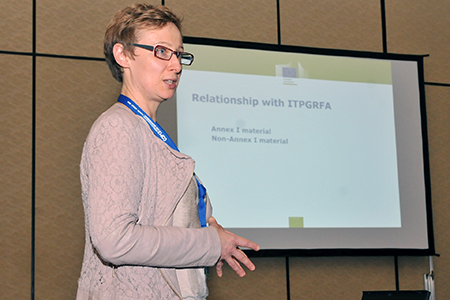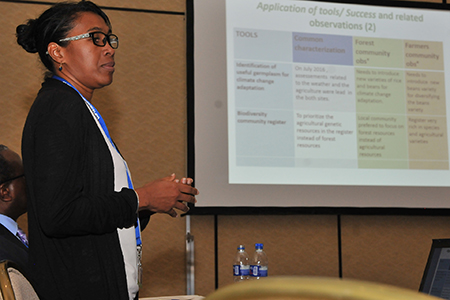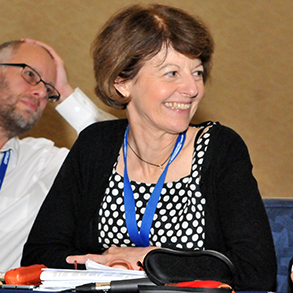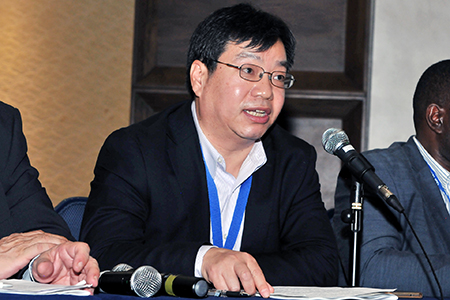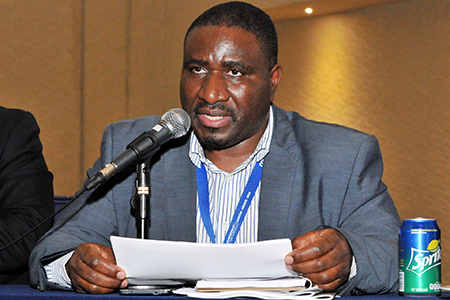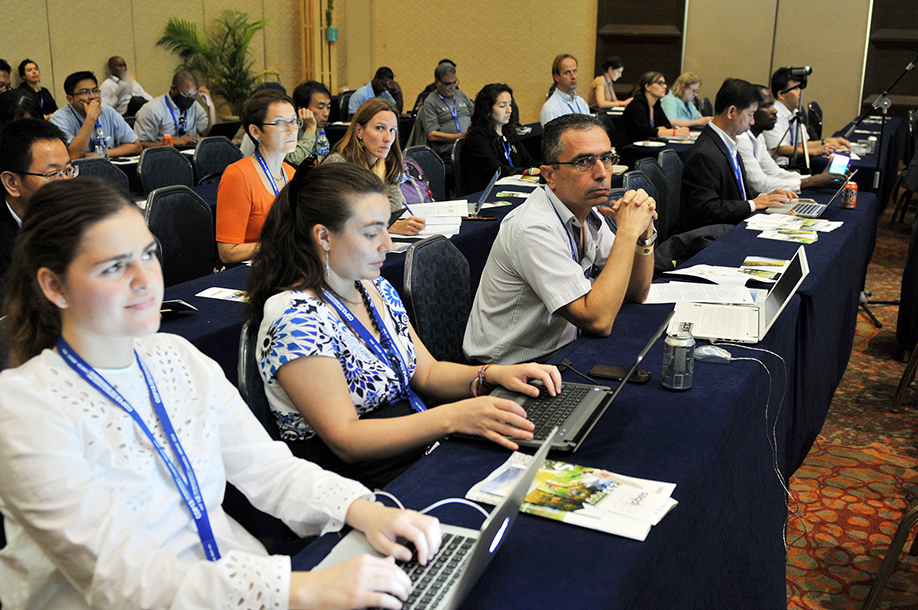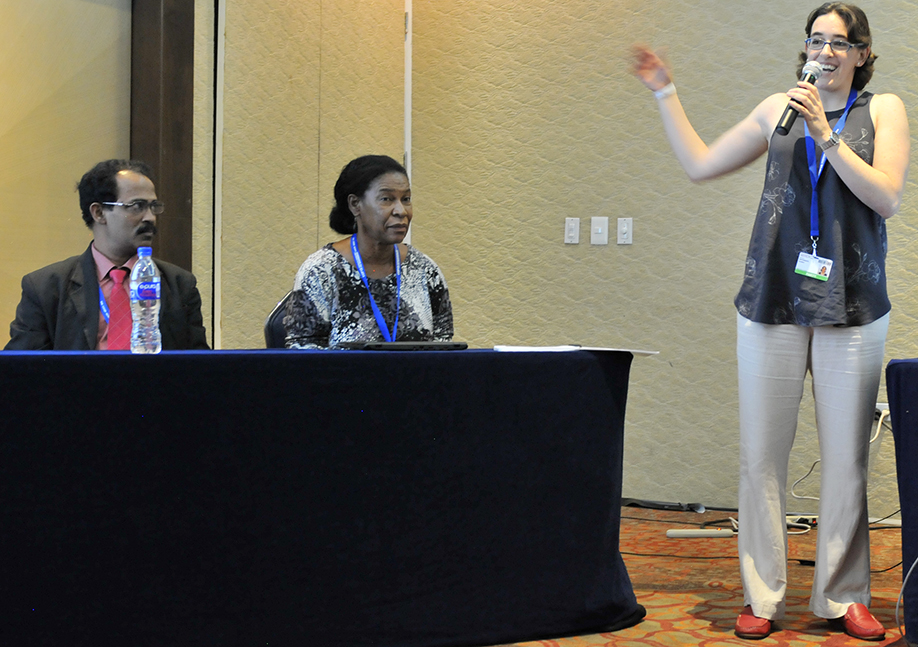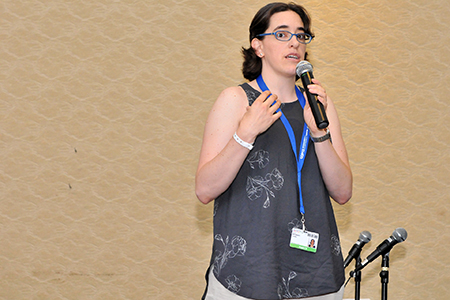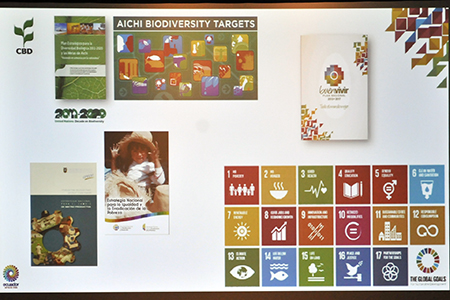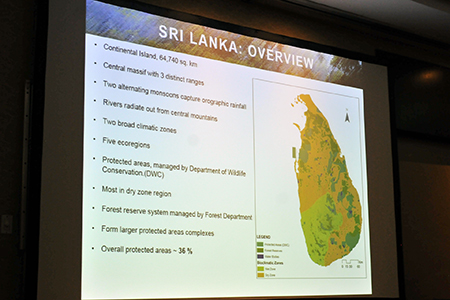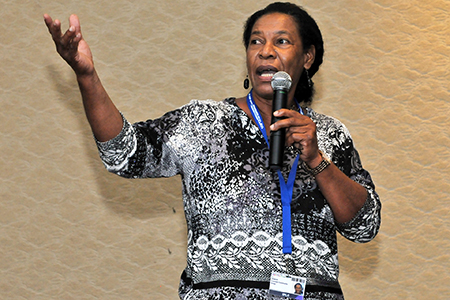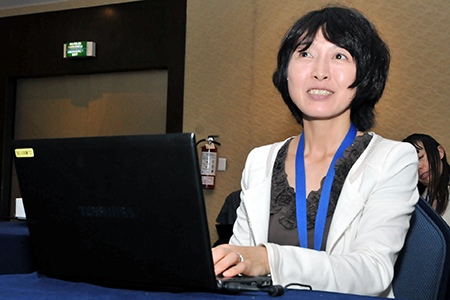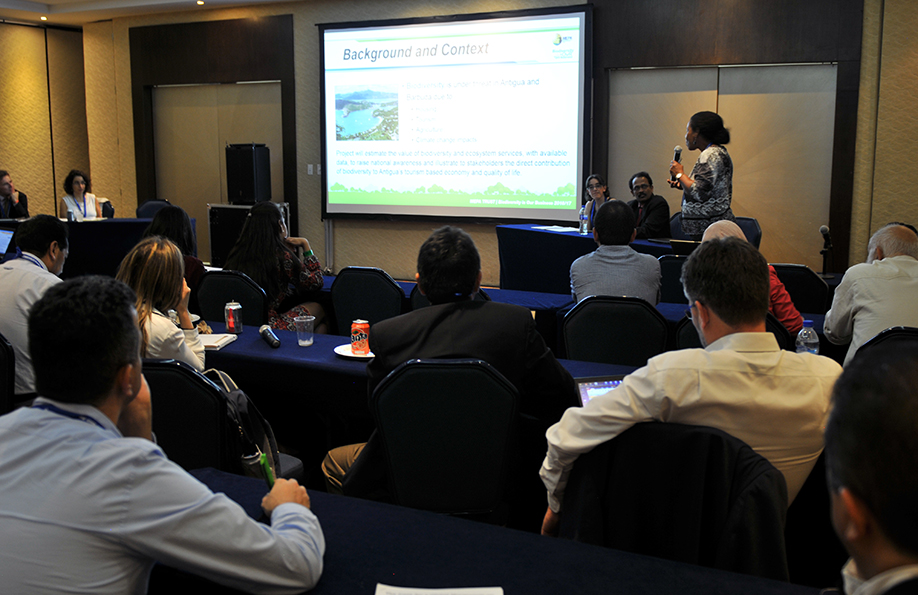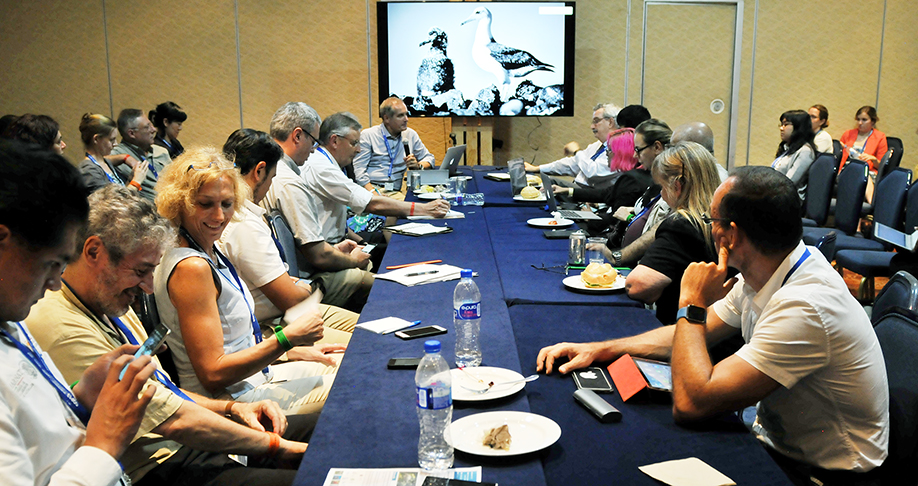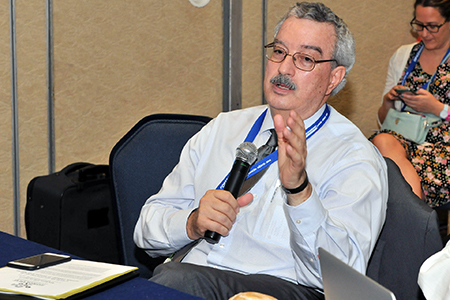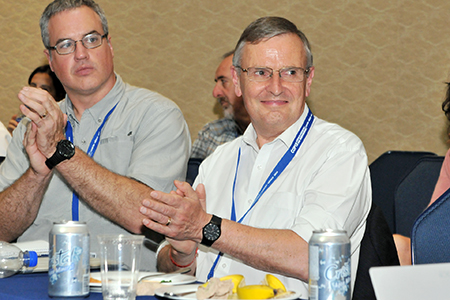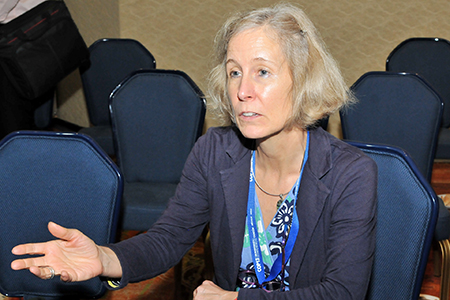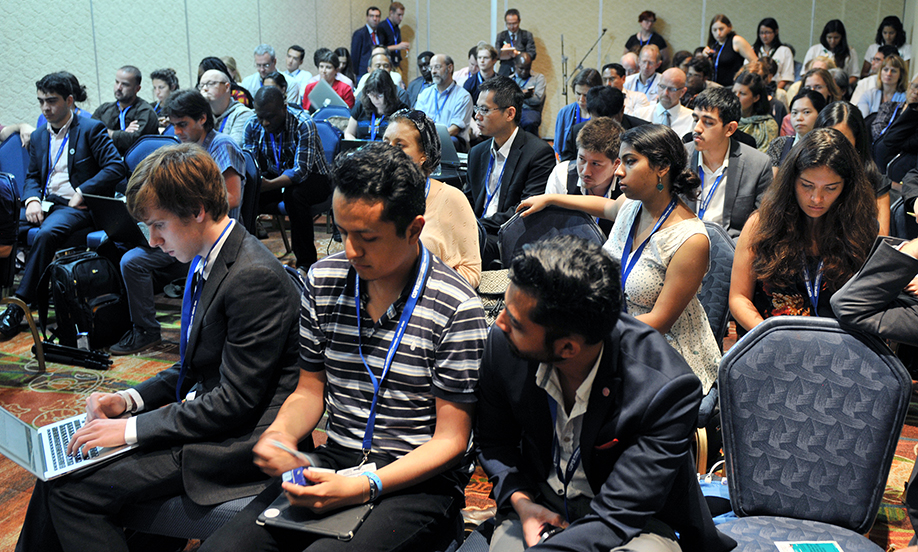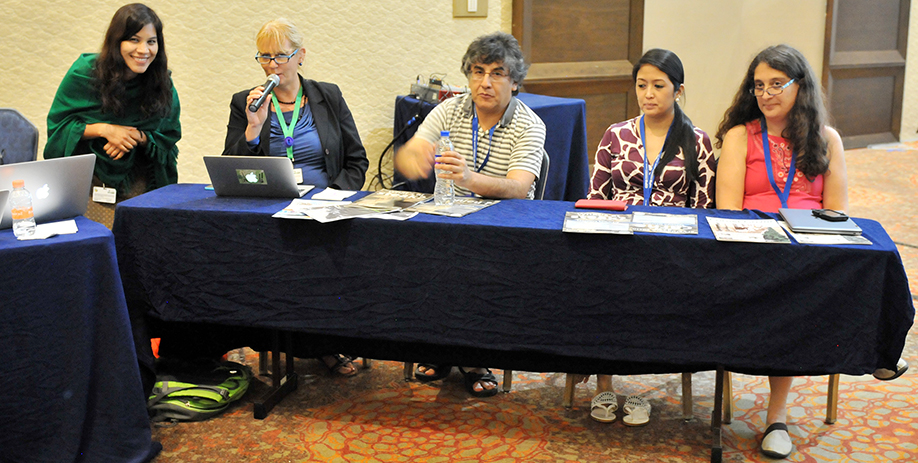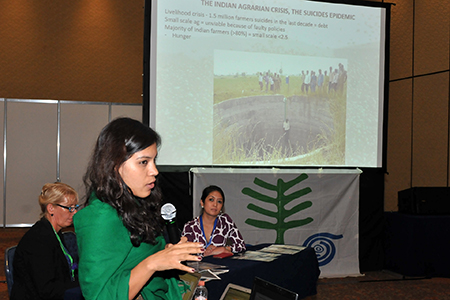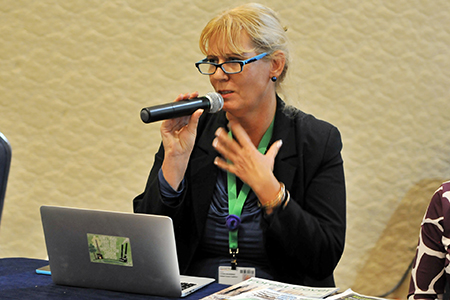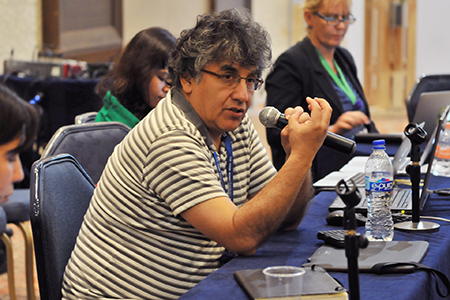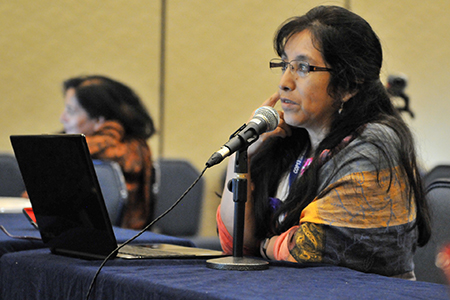Summary
The following events were covered by IISD Reporting Services On Tuesday, 6 December 2016:
- Towards a Modular Approach to Reporting Against the Aichi Biodiversity Targets and Sustainable Development Goals (SDGs)
- Mutually Supportive Implementation of the Nagoya Protocol and the Plant Treaty
- Summary for Policymakers from the IPBES Thematic Assessment on Pollinators, Pollination and Food Production
- Capacity Building for National Biodiversity Strategic Action Plan (NBSAP) Implementation: Lessons learned from pilot projects under the Japan Biodiversity Fund (JBF)
- To Halt the Tide of Invasive Alien Species (IAS) - Honolulu Challenge 2016
- CRISPR Gene Drives: The Implications of Extinction Technologies and Species-Scale Engineering
- Are We Improving and Supporting Sustainable Methods of Livestock and Agriculture to Achieve Aichi Target 7?
IISD Reporting Services, through its ENBOTS Meeting Coverage, is providing daily web coverage of selected side-events from the UN Biodiversity Conference.
Photos by IISD/ENB | Diego Noguera
For photo reprint permissions, please follow instructions at our Attribution Regulations for Meeting Photo Usage Page.
Towards a Modular Approach to Reporting Against the Aichi Biodiversity Targets and Sustainable Development Goals (SDGs)
Presented by the Swiss Confederation, Federal Office for the Environment (FOEN), and UN Environment Programme's World Conservation Monitoring Centre (UNEP-WCMC)
This side event presented innovative approaches to help parties to streamline their reporting to intergovernmental processes, through modular reporting based on the Aichi Biodiversity Targets, which also facilitates reporting on the SDGs by improving ways to use information more effectively.
Norbert Bärlocher, Swiss Confederation, FOEN, moderated the event, emphasizing the increasing need to ease reporting burdens on biodiversity-related multilateral environment agreements (MEAs) due to the increased amount of information available.
Gaston Akouehou, Chargé de Recherches au CAMES, Benin, presented on forest monitoring in West Africa, describing the structure of an action plan for regional collaboration that involves multipurpose forest monitoring. He said streamlined biodiversity-related reporting is feasible for reporting to the Food and Agriculture Organization of the UN (FAO) and REDD+.
Han De Koeijer, Focal Point, CBD Centre for Information Exchange, Belgium, reported on the Target Cross-linking Tool (TCT), aimed at facilitating data and information management. He demonstrated the complementarity of the TCT with the CBD voluntary online reporting tool and crosslinking with targets of biodiversity-related conventions including the CBD, the Ramsar Convention and the Convention on the Conservation of Migratory Species of Wild Animals (CMS).
Christoph Reusser, FOEN, and Katharina Bieberstein, UNEP-WCMC, presented jointly on elements for modular reporting against the Aichi Biodiversity Targets. Reusser said this project provides opportunities to explore the common use of national reporting data to increase information coherence and reduce the national reporting burden. Bieberstein said a more integrated approach to biodiversity loss resulting from the use of modular reporting will influence the development of a post-2020 global biodiversity framework and tools and processes related to the 2030 Agenda for Sustainable Development.
Frank Wugt Larsen, European Environment Agency, presented on the Data Reporting Tool (DaRT) for MEAs developed by the EU to cross-link biodiversity-related targets from national, to regional and global levels. The tool, he noted, will be made available to parties through UN Environment’s InforMEA platform.
In discussions, participants said any tools that relieve the reporting burden, while saving resources, should be used by all parties. Some noted that biodiversity-related national institutions are fragmented and that modular reporting tools would enable integration of the data they generate. They also noted the disparity in reporting among the different biodiversity-related conventions, saying the CBD has the highest reporting rate.
Speakers and participants during the event
Norbert Bärlocher, FOEN, said that national reporting burdens on biodiversity will be eased through new, innovative approaches.
Han De Koeijer, Focal Point, CBD Centre for Information Exchange, Belgium, demonstrated the interoperability between the TCT and the CBD voluntary online reporting tool.
Christoph Reusser, FOEN, said modular reporting will enable streamlining of data from biodiversity-related conventions.
Frank Wugt Larsen, European Environment Agency, said a volunteer initiative will be launched to establish concrete proposals for a modular approach to national reporting and to make DaRT available to all parties.
Katharina Bieberstein, UNEP-WCMC, said modular reporting requires countries to manage biodiversity data in a way that is useful for multiple processes.
Contact:
- Christoph Reusser (Coordinator)
| Christoph.RC.Reusser@bafu.admin.ch - Anne Teller (Coordinator)
| ENV-BIODIVERSITY@ec.europa.eu
More Information:
- http://www.sib.admin.ch/de/aktuell/modular-reporting/index.html
- https://www.informea/org
- https://demo.chm-cbd.net
Mutually Supportive Implementation of the Nagoya Protocol and the Plant Treaty
Presented by Bioversity International, the Access and Benefit Sharing (ABS) Capacity Development Initiative, the Convention on Biological Diversity (CBD) and the International Treaty on Plant Genetic Resources for Food and Agriculture (ITPGRFA)
This event addressed mutually supportive implementation of the Nagoya Protocol on Access to Genetic Resources and the Fair and Equitable Sharing of Benefits Arising from their Utilization to the CBD (the Nagoya Protocol) and the ITPGRFA (Plant Treaty) at international, regional, national and community levels.
Noting that the Multilateral System under the Plant Treaty and Nagoya Protocol are not self-executing Michael Halewood, Bioversity International, highlighted joint work of partner organizations in building stakeholder capacity.
Andreas Drews, Deutsche Gesellschaft für Internationale Zusammenarbeit (GIZ) GmbH, introduced the ABS Capacity Development Initiative to support the development and implementation of national ABS regulations. He noted that countries should identify those responsible for regulating and permitting access to genetic resources.
Pierre du Plessis, Namibia and Africa Region representative for the Conference of the Parties serving as the meeting of the Parties (COP/MOP) to the Nagoya Protocol, and the Governing Body of the Plant Treaty, stressed that implementing ABS correctly would lead to a “quadruple win” in Africa: ensuring conservation and sustainable use of biodiversity; promoting science, technology, knowledge and education; promoting climate change adaptation; and addressing poverty.
Alicja Kozlowska, European Commission (EC), highlighted the European Union’s (EU) legislation in this area, which is comprised of: the EU ABS Regulation; the Implementing Regulation; and complementary measures.
Naritiana Rakotoniaina Ranaivoson, National Focal Point for ABS, Madagascar, presented on a three-year project on mutually supportive implementation of the Nagoya Protocol and the Plant Treaty in Madagascar and Benin. Among key conclusions reached in Madagascar, she highlighted: the need to strengthen community structures before advancing participatory decision-making activities; and the value of knowledge on existing genetic resources for implementing both agreements, as well as for climate adaptation.
Kathryn Garforth, CBD Secretariat, expressed appreciation for assistance from the Japan Biodiversity Fund, which provides funding to follow up on commitments made at CBD COP 10 in Nagoya, Japan.
Kent Nnadozie, ITPGRFA Secretariat, highlighted the need for enhanced coordination among intergovernmental processes, as well as within donor countries and organizations.
During discussions, participants addressed, inter alia, “inherent tensions” between environmental and agriculture ministries that are less evident at the community level, and making guidance for implementation of the two agreements available in a flowchart.
Participants during the presentation of Pierre du Plessis, Namibia and and Africa Region representative for the COP/MOP to the Nagoya Protocol and the Governing Body of the Plant Treaty
Michael Halewood, Bioversity International, stressed capacity building is critical to enable stakeholders to take advantage of the Nagoya Protocol and Plant Treaty.
Pierre du Plessis, Namibia and Africa Region representative for the COP/MOP to the Nagoya Protocol and the Governing Body of the Plant Treaty, said Africa’s Agenda 2063 provides an optimistic global strategy to optimize the use of African resources, and stressed “we should do everything we can to make the dream come true.”
Alicja Kozlowska, EC, presented on elements of the Plant Treaty within and outside the scope of the EU ABS Regulation.
Nartiana Rakotoniaina Ranaivoson, National Focal Point for ABS, Madagascar, stressed the need to consider how international instruments can respond to communities’ aspirations and needs.
Participants during the event
Contact:
- Michael Halewood (Coordinator)
| m.halewood@cgiar.org
More Information:
- http://www.bioversityinternational.org/research-portfolio/policies-for-plant-diversity-management/mutual-implementation-of-nagoya-protocol-and-plant-treaty/
- http://www.abs-initiative.info/
Summary for Policymakers from the IPBES Thematic Assessment on Pollinators, Pollination and Food Production
Presented by the Intergovernmental Science-Policy Platform on Biodiversity and Ecosystem Services (IPBES) Secretariat
This event, moderated by Anne Larigauderie, Executive Secretary, IPBES, focused on countries’ reflections, plans and actions to implement key findings of the IPBES pollination assessment.
Simon Potts, University of Reading, summarized key messages in the Summary for Policymakers, emphasizing the value of pollinators for agriculture production and other ecosystem services. He reported that the annual market value linked to pollinators is US$235-577 billion.
Lejo van der Heiden, Ministry of Economic Affairs, the Netherlands, introduced the “Coalition of the Willing on Pollinators,” launched at the High-Level Segment of COP 13. He reported that this Coalition aims to encourage strategies for pollinator conservation through sustainable agricultural practices, improved management of pollinators and restoration of natural habitats in urban areas.
Jean-Patrick Le Duc, Cabinet Director, Ministry of Biodiversity, France, reported on the French National Pollinator Action Plan, which lays out strategies to use tools and approaches to enhance awareness and protect pollinators, adding that 4,000 local authorities are committed to zero pesticide use.
Chengshou Bai, Protected Areas National Focal Point, China, highlighted his country’s pollinator’s assessment and implementation strategies. He reported on the need to, inter alia: survey pollinator diversity; assess the value of pollination services; establish a pollination monitoring system; formulate pollinator conservation and restoration activities; enhance policy support; and expand publicity and increase public participation.
Shonisani Munzhedzi, Department of Environmental Affairs, South Africa, reported on scientific research and policy interventions including the honeybee forage project and policy precaution measures. He noted the need to enhance legislation and to consider the role of indigenous knowledge systems.
Carlos Scaramuzza, Ministry of Environment, Brazil reported on actions to ensure the coexistence between agriculture and conservation and increased food production including: improved use of pesticides and promotion of biological control agents; pesticide risk assessments that include bees; and improved family farm production methods.
In ensuing discussions, some participants noted that the report on pollination, pollinators and food production does not recognize the existence of laboratory and field-based data on the effects of genetically-modified crops; and the need to include more information on the protection of urban species of pollinators.
(L-R): Hien Ngo, IPBES Secretariat; Simon Potts, University of Reading; Anne Larigauderie, Executive Secretary, IPBES; Chengshou Bai, Protected Areas National Focal Point, China; Shonisani Munzhedzi, Department of Environmental Affairs, South Africa; and Lejo van der Heiden, Ministry of Economic Affairs, the Netherlands
Anne Larigauderie, Executive Secretary, IPBES, said the Thematic Assessment on Pollinators, Pollination and Food Production was presented to and welcomed by the 12th meeting of the Subsidiary Body on Scientific Technical and Technological Advice.
Simon Potts, University of Reading, reported a more than 300% increase in the volume of agricultural production that depends on pollinators since 1961.
Jean-Patrick Le Duc, Ministry of Biodiversity, France, reported that the France National Assembly has recently approved a ban on bee-harming neonicotinoid pesticides, which will take effect in late 2018.
Chengshou Bai, Protected Areas National Focal Point, China
Shonisani Munzhedzi, Department of Environmental Affairs, South Africa, said the science-policy interface needs to be broadened to include “society and practice.”
Participants listening to panelists
Contact:
- Hien Ngo (Organizer)
| hien.ngo@ipbes.net
More Information:
Capacity Building for National Biodiversity Strategic Action Plan (NBSAP) Implementation: Lessons learned from pilot projects under the Japan Biodiversity Fund (JBF)
Presented by the Convention on Biological Diversity (CBD)
This side event, moderated by Nadine Saad and Nicolaas van der Werf, CBD, presented demonstration projects that several countries have undertaken to implement NBSAPs, including through spatial data and mainstreaming biodiversity across sectors.
Fumiko Nakao, Ministry of Environment, Japan, emphasized that JBF’s priority is to ensure capacity building for NBSAP implementation.
Macarena Bustamante, Consortium for the Sustainable Development of the Andean Ecoregion (CONDESAN), presented a pilot project to: review and align Ecuador’s NBSAP to the Aichi Biodiversity Targets; collect and organize data available to support NBSAP monitoring; and integrate socioeconomic and spatial information to analyze the impact of mangrove conservation for human wellbeing.
Leel Randeni, Ministry of Mahaweli Development and Environment, Sri Lanka, noted the priorities of the capacity-building pilot project as: identifying priorities for the country’s NBSAP; integrating those priorities into the country’s development plans; and building capacity within governmental agencies for improved biodiversity planning.
Ruth Spencer, Marine Ecosystem Protected Area Trust, Antigua and Barbuda, presented the ‘Biodiversity is our Business’ pilot project, which aims to value ecosystem services for biodiversity protection given the crucial role of biodiversity for tourism and for the protection of coastal areas. She said the outputs of the project would be to develop island-wide ecosystem services valuation through the use of digital maps to inform policymakers.
Abisha Mapendembe, UN Environment Programme-World Conservation Monitoring Centre (UNEP-WCMC), presented a method of digitally mapping biodiversity priorities to assist in national biodiversity assessment and prioritization. He highlighted the role of maps in classifying ecosystem types, setting biodiversity targets according to ecosystem, and identifying priority areas for achieving targets.
In the ensuing discussion, participants considered: who should be responsible for implementing NBSAPs; who assesses biodiversity priorities; the role of indigenous peoples and local communities in determining priorities; and the potential for collaboration with universities and local research institutes to promote capacity building.
(L-R): Leel Randeni, Ministry of Mahaweli Development and Environment, Sri Lanka; Ruth Spencer, Marine Ecosystem Protected Area Trust, Antigua and Barbuda; and Macarena Bustamante, CONDESAN
Macarena Bustamante, CONDESAN, emphasized how a capacity-building pilot project in Ecuador is contributing to aligning the country’s NBSAP with the Aichi Biodiversity Targets and the National Development Plan of Buen Vivir.
A slide from Macarena Bustamante’s presentation
A slide from Leel Randeni’s presentation
Leel Randeni, Ministry of Mahaweli Development and Environment, Sri Lanka, highlighted the use of “smart” infrastructure designs, restoration of forest cover in strategic areas and the use of payments for ecosystem services to ensure biodiversity conservation.
Ruth Spencer, Marine Ecosystem Protected Area Trust, Antigua and Barbuda, emphasized that ecosystems must not be given away to hotel projects in Antigua if these initiatives are not enhancing the country’s resilience to climate change.
Fumiko Nakao, Ministry of Environment, Japan, said it is Japan's responsibility to ensure capacity building to achieve the Aichi Biodiversity Targets.
Participants during the event
Contact:
- Maroun Abi Chahine (Coordinator)
| maround.abichahine@cbd.int
More Information:
- https://www.cbd.int/jbf/
- http://biodiversityadvisor.sanbi.org
- http://wcmc.io/mapping_biodiversity_priorities
To Halt the Tide of Invasive Alien Species - Honolulu Challenge 2016
Presented by the Convention on Biological Diversity (CBD), International Union for Conservation of Nature (IUCN), the Commonwealth Scientific and Industrial Research Organisation (CSIRO), BirdLife International, the Global Biodiversity Information Facility (GBIF) and the IUCN Invasive Alien Species Specialist Group (ISSG)
This side event, moderated by Piero Genovesi, ISSG, discussed the challenges posed by invasive alien species (IAS) and described the Honolulu Challenge on IAS, welcoming future commitments.
Jane Smart, IUCN, described the work of IUCN, including the creation of a unit to forward the knowledge and action-oriented work on IAS pathways and sensitive sites through a user-friendly portal.
Marina von Weissenberg, Department of the Natural Environment, Finland, drew attention to the International Agreement for the Control and Management of Ships’ Ballast Water and Sediments and its relation to IAS in marine ecosystems.
Andrew Bignell, New Zealand, highlighted a US$3 billion project to eradicate possums, rats and stoats. He stressed the importance of new science, a participatory approach and investment; and highlighted the country’s Cancún Commitment on the mobilization of international efforts to address IAS.
A representative of Barbara Pompili, Minister of State for Biodiversity, France, said that the country has passed a new law to address IAS, noting that a decree on IAS is in the pipeline. She called for caution in addressing IAS, noting that some methods could have negative unintended consequences.
Carolina Hazin, BirdLife International, underscored that IAS have been the major driver of bird extinctions in the past century, noting the organization’s commitment to the Honolulu Challenge and highlighting BirdLife International’s target to have 35 high-biodiversity islands IAS-free by 2020.
Heath Packard, Island Conservation, noted the organization’s focus on ridding biodiversity-rich islands of IAS, and pointed to a database of island invasive species eradications, which has been successful in addressing 1,100 IAS cases.
Federico Méndez Sánchez, Grupo de Ecologia y Conservacíon de Islas (Group on Conservation and Ecology of Islands), reiterated his organization’s commitment to eradicate invasive mammal species, noting that 58 IAS have already been addressed and that in four years, 37 more IAS are projected to be eradicated in many islands in Mexico.
Stuart Chape, Secretariat of the Pacific Regional Environment Programme, highlighted actions to address IAS in the Pacific, including information sharing, awareness raising, the establishment of a peer learning network of Pacific invasive species practitioners, biosecurity training and the development of biological controls.
Stefan Leiner, European Commission, stressed that IAS is a top priority in the EU and is addressed through the development of legislation applicable in all 28 states, with guidance from the CBD.
Braulio Ferreira de Souza Dias, CBD Executive Secretary, stressed that although addressing IAS is not cheap, it is cost effective. He lauded the Honolulu Challenge as well as the leadership of New Zealand in addressing IAS, expressing hope that Aichi Biodiversity Target 9 (IAS) will be achieved in time.
Speakers and participants during the event
Piero Genovesi, ISSG, noted that IAS are a growing problem in all environments in the world and require urgent action, but lamented that although the solutions are known, urgent action is yet to be taken.
Braulio Ferreira de Souza Dias, CBD Executive Secretary, stressed that in order to be credible, the Conference of the Parties (COP) to the CBD must achieve the Aichi Biodiversity Targets by 2020 so as to adopt an even more ambitious strategic plan.
Andrew Bignell, New Zealand, highlighted the losses from agriculture and administration costs due to inaction on IAS which far surpass the US$3 billion required to eradicate these species.
Jane Smart, IUCN, highlighted that IAS considerations are being integrated into the IUCN Red List.
Contact:
- Piero Genovesi (Coordinator and Moderator)
| piero.genovesi@isprambiente.it
More Information:
CRISPR Gene Drives: The Implications of Extinction Technologies and Species-Scale Engineering
Presented by the Federation of German Scientists (FGS), ETC Group and EcoNexus
This session, moderated by Helena Paul, EcoNexus, focused on the potential ethical, social and environmental implications of Clustered Regularly Interspaced Short Palindromic Repeats (CRISPR) gene drives technology, and how it should be addressed.
Jim Thomas, ETC Group, described gene drives as a genetically engineered trait which will “mostly or always” be passed on to future generations and become dominant in a population, take over a population and potentially take over a species. Noting that this “ecological engineering” technology has the potential to change or eradicate entire species and ecosystems, Thomas said that laboratory work should not move ahead until we have very clear standards on how to contain this technology.
Christine von Weizsäcker, European Network for Ecological Reflection and Action (ECOROPA), highlighted: the importance of the precautionary principle; “a problem-and-solution-oriented discourse” as being more appropriate than one centered on technology; and a need to slow down the release of new products while speeding up research on their impacts.
Neth Daño, ETC Group, highlighted ongoing applications of gene drives technology, such as for controlling vector-borne diseases and in agriculture, in which hundreds of millions of dollars are being invested. She cautioned against losing sight of the political economy and the “context in which these technological hypes are happening.”
Ricarda Steinbrecher, FGS, noted that altering or causing extinction of entire species raises major ethical, social and environmental issues, and that “we do not even know which questions we should be asking.” She called for additional time to ensure appropriate biocontainment facilities are in place for any research, and to develop appropriate risk assessment guidance, safety requirements and governance.
In the discussion, participants questioned: the duration of a potential moratorium on gene drives technology, given that “people are dying of malaria and hunger”; and whether holding a dialogue between civil society and scientists would be more appropriate than a moratorium. Panelists stressed, inter alia, the need to address the “very unequal power relations” of any such dialogue, and for guidelines to be in place before applications are discussed.
(L-R): Christine von Weizsäcker, ECOROPA; Helena Paul, EcoNexus; Ricarda A. Steinbrecher, FGS; and Neth Daño, ETC Group
Neth Daño, ETC Group, stressed “we should not be deluding ourselves that these technologies are free from the socio-political context.”
Jim Thomas, ETC Group, highlighted a recent call, supported by 168 civil society groups, for a moratorium on genetically-engineered gene drives.
Ricarda Steinbrecher, FGS, emphasized the need to question “who is making the decisions, and what if the technology falls in the wrong hands.”
Participants during the event
Contact:
- Helena Paul (Moderator)
| h.paul@gn.apc.org
More Information:
Are We Improving and Supporting Sustainable Methods of Livestock and Agriculture to Achieve Aichi Target 7?
Presented by the Global Forest Coalition (GFC)
This side event, moderated by Simone Lovera, Executive Director, GFC, discussed industrial agriculture as the major cause of biodiversity loss, particularly in Latin America, which compromises Aichi Biodiversity Target 7 on sustainably-managed forests and agriculture.
Mary Louise Malig, GCF, presented findings from the GFC’s report titled ‘What’s at Steak? The Real Cost of Meat,’ noting, inter alia, the direct link between the corporate growth of the livestock sector and growing deforestation, and that distorted World Trade Organization subsidies enable large agri-businesses to “dump” their goods at prices lower than the cost of production.
Ines Franceschelli, Namoseke Monsanto, Paraguay, stressed that globalized meat production is “controlling the territory” of the country by destroying the biodiversity of its soils and forests. She underscored the dangers of the industrialization of agriculture in terms of reducing human health, increasing poverty, preventing food sovereignty and failing to respect basic human rights.
Leticia Tura, Federation of Organs for Social and Educational Assistance (FASE), highlighted that Brazil: is one of the world’s largest global exporters of soy, beef and poultry; adopts a production model that is based on monocultures; and is a “world champion in the use of agro-toxins” which damage the soil, contaminate water, reduce food sovereignty and cause health impacts. She stressed that meat production is one of the major causes of deforestation in Brazil, but lamented that public subsidies for large transnational agri-industries have only been increasing in recent years.
Pablo Solón, Solón Foundation, spoke about a technique in Bolivia to create forest fires to produce new pasture for the country’s expanding cattle industry. He noted the need to promote agroforestry, soil conservation measures, strict regulation and behavioral change to curtail the impacts of the growing livestock industry on Bolivia’s biodiversity.
Ashlesha Khadse, Amrita Bhoomi, discussed the growing agrarian crisis in India in which 1.5 million farmers have committed suicide in recent years due to indebtedness from expensive inputs, low prices and unfavorable trade policies. She noted that the growth of industrial “mega-dairies” and poultry farms by multinational companies imposes high penalties and disadvantages to smallholders, who represent 80% of India’s farmers.
In the ensuing discussion, participants discussed: ways to ensure perverse incentives are discouraged if biodiversity financing is to be assured; the gap between discourse and practice in Bolivia’s actions towards biodiversity conservation; and the political aspects of global food production.
(L-R): Ashlesha Khadse, Amrita Bhoomi; Simone Lovera, Executive Director, GFC; Pablo Solón, Solón Foundation; Mary Louise Malig, GFC; and Leticia Tura, FASE
Ashlesha Khadse, Amrita Bhoomi, stressed that the government must ensure minimum support prices for India’s dairy farmers and that “foreign direct investment in agriculture must be prohibited.”
Simone Lovera, Executive Director, GFC
Pablo Solón, Solón Foundation, noted that the number of fires to produce new pastures for cattle grazing in Bolivia has markedly increased in 2016.
A participant during the discussion
Contact:
- Mary Louise Malig (Coordinator)
| marylouisemalig@globalforestcoalition.org

